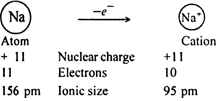 Short Answer Type
Short Answer Type
 Long Answer Type
Long Answer TypeWhat do you understand by isoelectronic species? Name a species that will be isoelectronic with each of the following atoms or ions.
(i) F- (ii) Ar (iii) Mg2+ (iv) Rb+
Consider the following species : N3-, O2-, F-, Na+, Mg2+ and Al3+
(a) What is common in them?
(b) Arrange them in the order of increasing ionic radii.
 Short Answer Type
Short Answer TypeGive the formula of a species which will be isoelectronic with the following atoms or ions:
(i) Na2+
(ii) Cl-
(iii) Ca2+
(iv) Rb+.
Which of the following species will have the largest and the smallest size?
Mg, Mg2+, Al, Al3+.
Arrange the following ions in order of increasing size:
Be2+, Cl-, S2-, Na+, Mg2+, Br-.
 Long Answer Type
Long Answer TypeIn each of the following pairs, which species has a larger size? Explain.
(i) K or K+
(ii) Br or Br-
(iii) O2- or F-
(iv) Li+ or Na+
(v) P or As
(vi) Na+ or Mg2+
